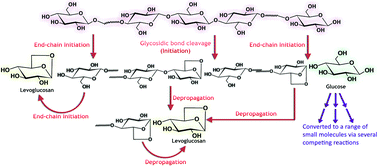A mechanistic model of fast pyrolysis of glucose-based carbohydrates to predict bio-oil composition†
Abstract
Bio-oil obtained from fast

* Corresponding authors
a
Department of Chemical and Biological Engineering, Northwestern University, 2145 Sheridan Road, Evanston, IL 60208, USA
E-mail:
broadbelt@northwestern.edu
Fax: +1-847-491-3728
Tel: +1-847-491-5351
Bio-oil obtained from fast

 Please wait while we load your content...
Something went wrong. Try again?
Please wait while we load your content...
Something went wrong. Try again?
R. Vinu and L. J. Broadbelt, Energy Environ. Sci., 2012, 5, 9808 DOI: 10.1039/C2EE22784C
To request permission to reproduce material from this article, please go to the Copyright Clearance Center request page.
If you are an author contributing to an RSC publication, you do not need to request permission provided correct acknowledgement is given.
If you are the author of this article, you do not need to request permission to reproduce figures and diagrams provided correct acknowledgement is given. If you want to reproduce the whole article in a third-party publication (excluding your thesis/dissertation for which permission is not required) please go to the Copyright Clearance Center request page.
Read more about how to correctly acknowledge RSC content.
 Fetching data from CrossRef.
Fetching data from CrossRef.
This may take some time to load.
Loading related content
